10 Jul 2025
8 MIN READ
Panama Canal Problems and Global Trade Tensions: What You Need to Know in 2025
Summary
In 2025, the Panama Canal is facing unprecedented challenges. Severe drought conditions, compounded by escalating geopolitical tensions, have disrupted global trade and commerce. This vital waterway, which accounts for 5% of international maritime traffic, has experienced a significant decline in vessel transits, resulting in supply chain delays, increased shipping costs, and rerouted cargo. The Panama Canal remains a crucial route connecting Asia, the Americas, and Europe. But the current crisis raises questions about the future of global logistics and trade.
Decoding the Recent Panama Canal Issues
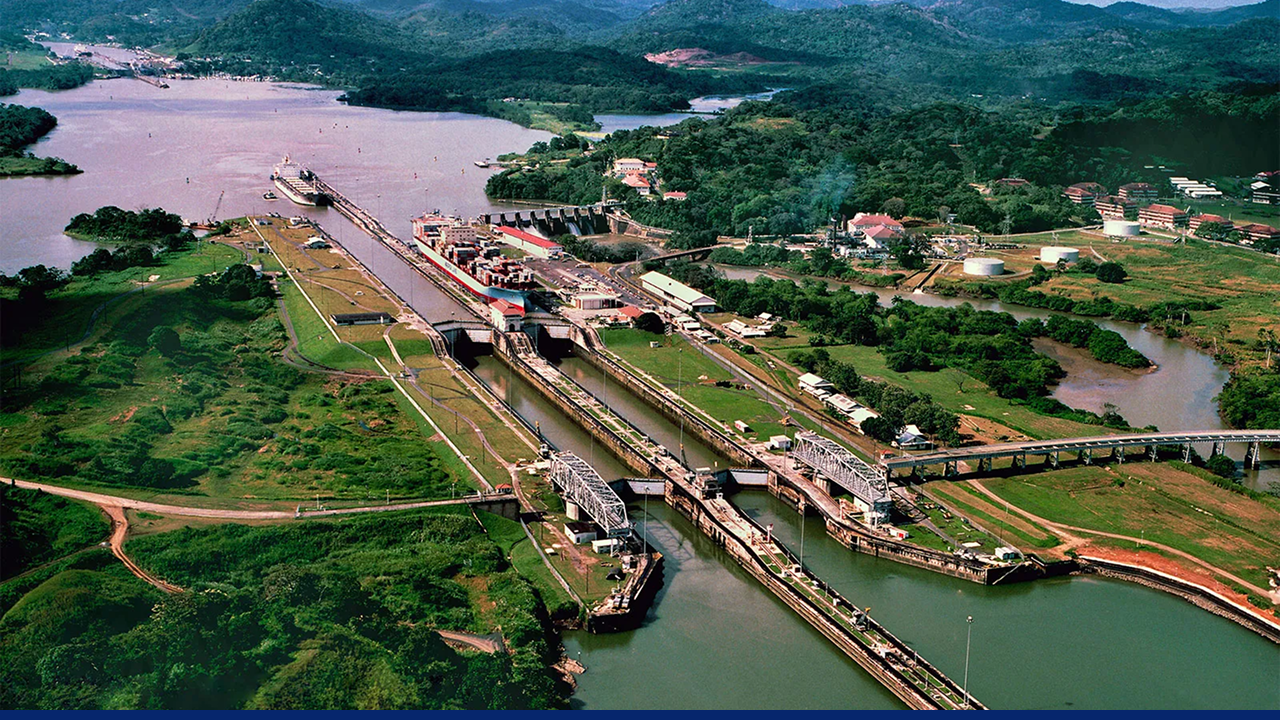
Aerial view of the Panama Canal with cargo ships navigating through locks. A critical artery for global trade that connects the Atlantic and Pacific Oceans. Credits: Britannica
By late 2022, drought conditions began to take hold at the Panama Canal. By 2024, it was declared one of the worst droughts in its 110-year history. According to the latest update, the Panama Canal Authority (PCA) reported a 29% decline in vessel transits during fiscal year 2024, with LNG and dry bulk shipments among the most significantly impacted.
In addition to the two years of record drought conditions amid a challenging El Niño weather system, the Panama Canal is experiencing a trade rebound. The PCA enforced a 40% reduction in vessel traffic to conserve water in February 2024. Bottlenecks formed as ships waited in long queues, intensifying delays and global shipping congestion.
The role of climate change in ongoing canal problems
Experts point to Lake Gatún, a freshwater reservoir that feeds the Panama Canal, whose levels have dropped dangerously low. Reliant on rainwater, the canal has suffered under changing climate patterns and a persistent El Niño system, resulting in the second driest year on record.
How Have Panama Canal Problems Escalated Global Trade Tensions?
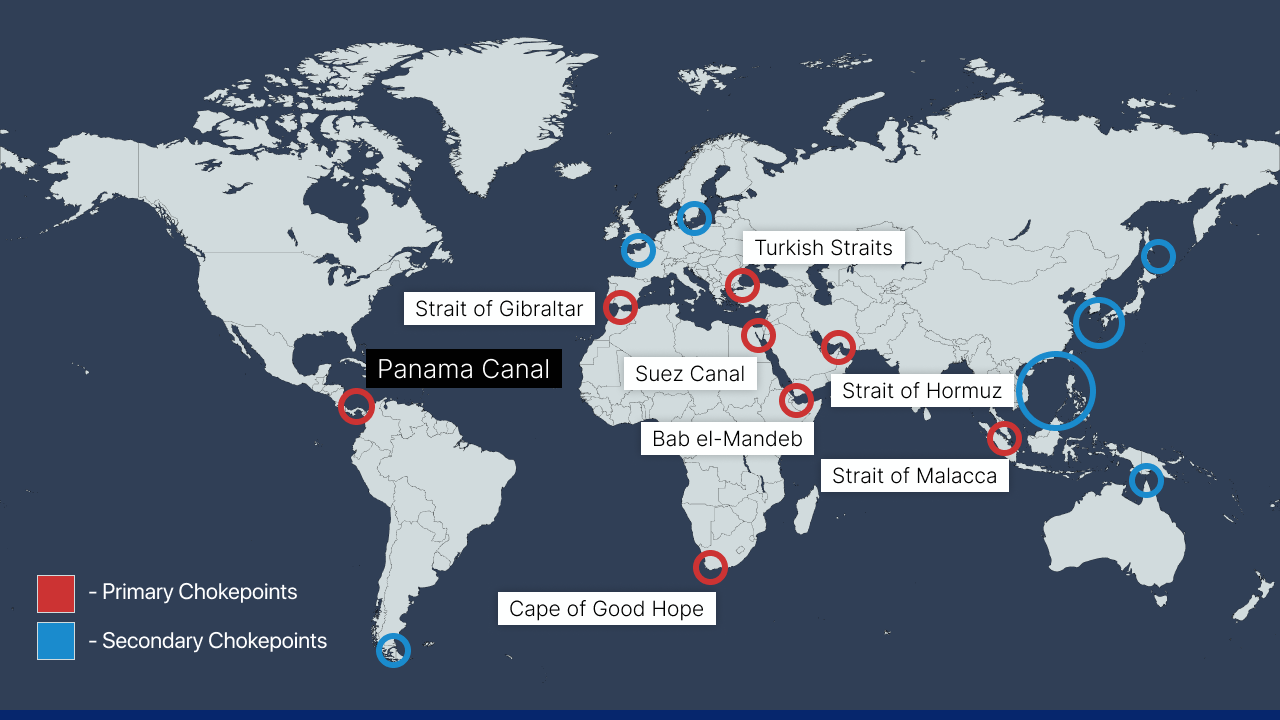
The world's major maritime chokepoints, including primary routes like the Panama Canal, Suez Canal, and Strait of Hormuz, are critical to global trade, energy flows, and geopolitical stability. Credits: Farm Bureau
The Panama Canal’s slowdown has fueled trade tensions amid an already fragile geopolitical climate. The PCA must balance canal operations with supplying drinking water to nearly half of Panama’s population, adding urgency and complexity to every decision. The changing rainfall patterns highlight the climate risks threatening global trade infrastructure.
Impact on the US economy and global trade
The Panama Canal problem is critical to the U.S. economy and trade. They are the largest users of the Panama Canal, with total U.S. commodity exports and imports representing approximately 73% of Panama Canal traffic and 40% of all U.S. container traffic passing through the Panama Canal each year. In all, roughly $270 billion in cargo is handled annually.
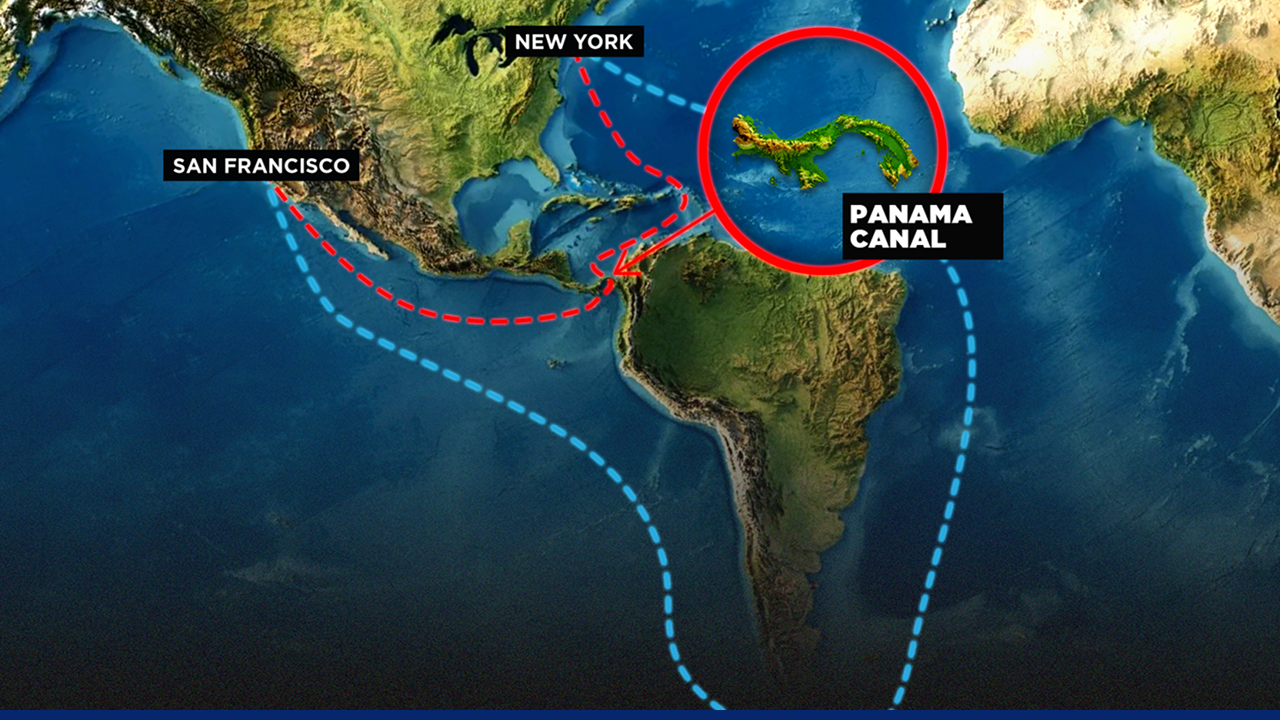
source-Trade routes from San Francisco to New York, highlighting the Panama Canal shortcut (red) versus the longer Cape Horn route (blue), emphasizing the canal’s role in global maritime efficiency. Credits: Foundation for Economic Education
The Ripple Effect: Panama Canal Issues and Global Trade Disruption
The Panama Canal is widely recognized for facilitating global trade and connecting routes from Asia, the US, Europe, and other regions. The canal, which spans approximately 82 kilometers, accounts for around 5% of global maritime trade. The activity has also reduced shipping time and costs compared to alternative routes, such as the Cape of Good Hope.
What will it bring to global trade if the Panama Canal problems are heightened?
Any unanticipated disruptions in trade activity at the Panama Canal will have a direct ripple effect that extends beyond the U.S. and Panama. Trading nations, such as China, Japan, and Latin American countries that rely on the route, will be severely affected.
The drought, as mentioned above, has already caused a drop in daily transits from 38 to just 18 due to water shortages. Further problems will lead to loss of access or investment in long-term solutions, and global trade could face severe bottlenecks.
Which trade faces the severe impact of the Panama Canal escalating problem?
Ongoing geopolitical tensions (U.S.-China-Panama) could worsen the situation with tariffs, sanctions, or shipping restrictions, further disrupting LPG flows. The drought has also had a direct impact on global goods passing through the Canal.
The LPG trade has been hit hardest by the canal's restrictions. Very Large Gas Carriers (VLGCs), which transport LPG from the U.S. to Asia, need more water to pass. The canal’s drought has slashed daily ship transits, pushing shipping rates on routes like Houston to Chiba (Japan) to record highs — $250/ton by late 2024.
Alternative Strategies Amid Panama Canal Problems
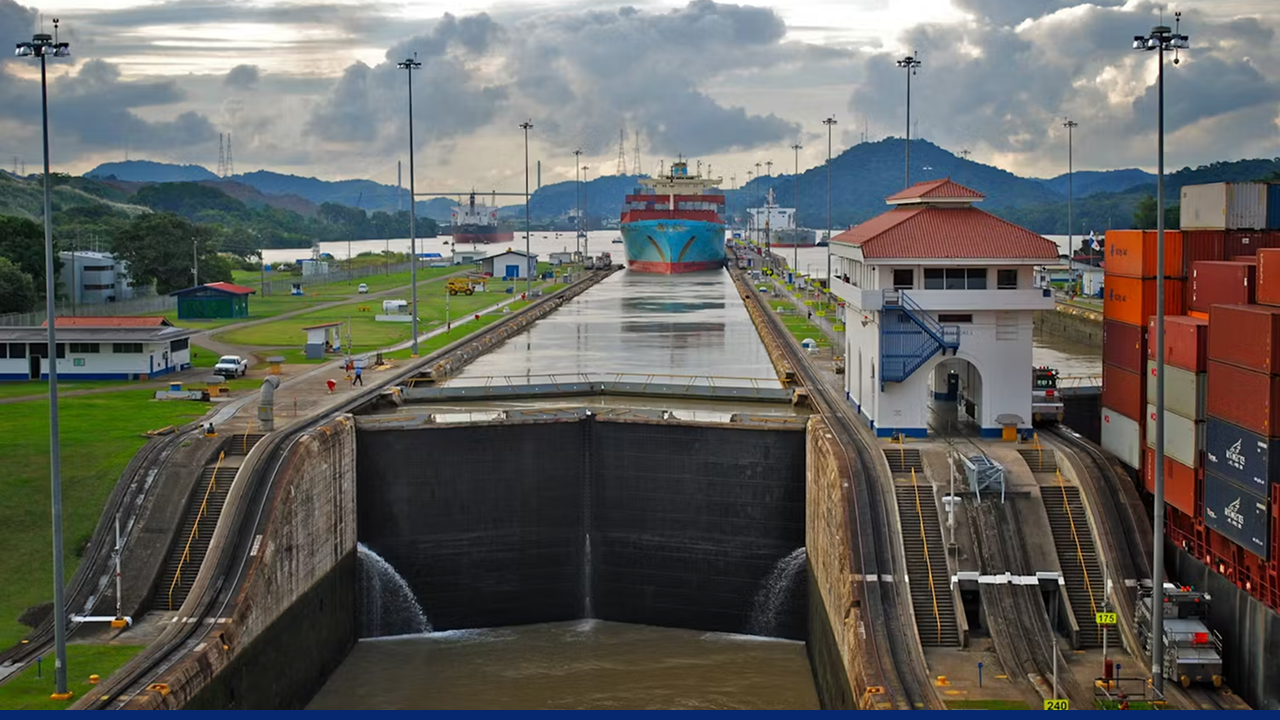
A container ship transits through the Panama Canal's lock system, an essential engineering feat that enables global maritime trade by connecting the Atlantic and Pacific Oceans. Credits: World Monuments Fund
Amid the chaotic situation at the Panama Canal and the rising tide of problems, observers have proposed alternative strategies to drive solutions for damage control. Ricaurte Vásquez, Administrator of the Panama Canal Authority, has shared that operational investments and technologies are helping to increase trade.
In other alternative strategies, the Panama Canal’s decision to introduce a fully booked system has led to an increase in the average size of vessels. This has allowed more containers to pass through the canal on fewer vessels. Thus, saving water helps reduce wait times. This strategy also guided a windfall of between $400 M - $450 M in the fourth quarter.
Some ships carrying cargo from Asia were rerouted through the Suez Canal before the current Red Sea crisis. With that option less secure, there has been an increase in demand for rail and road transport across Panama.
Managing Global Trade Tensions Through Resilience
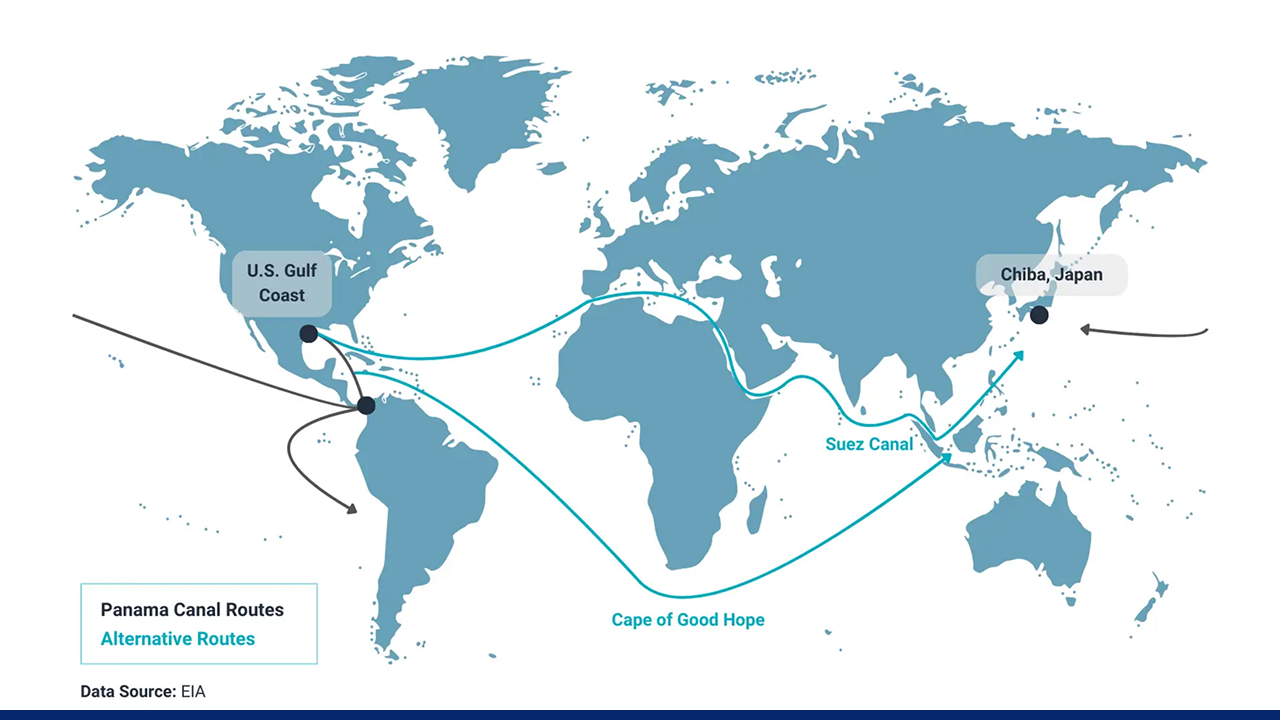
Trade routes from the U.S. Gulf Coast to Chiba, Japan, highlighting the Panama Canal as the primary route and the Suez Canal and Cape of Good Hope as longer, costlier alternatives. Credits: Log-hub
Understanding the way forward for Panama Canal issues is a challenging and labor-intensive task. However, resilient solutions and alliances are among the key factors in addressing this problem, which is impacting global trade.
Will strengthening supplier collaboration pave the way?
In 2025, as the problem in the canal has escalated, one solution is the maintain an open relationship with suppliers. In the case of Unilever, they have utilized their supplier forums to collaborate with partners and address the issues caused by the drought affecting the Panama Canal. This enabled continuity despite supply chain disruptions.
Will cloud seeding be the beacon of hope in the Panama Canal?
Cloud seeding is a weather modification technique used to increase rainfall, something Panama hopes could refill its water reservoirs. A resilient approach to tackling the crisis and drought. This method, which involves implanting large salt particles into clouds to increase rainfall, has been around since the 1940s.
Adoption of artificial intelligence
Another option to find solutions to the Panama Canal crisis is the adoption of AI. It will reduce trade disruptions by adjusting inventory levels and production schedules to anticipate and mitigate potential hazards.
Windward’s Maritime AI platform empowers stakeholders to efficiently manage the changing landscape by providing the tools needed to navigate unexpected hurdles. The PCA, shipping, and ocean freight stakeholders must navigate this challenge through alliance and collaboration.
Conclusion
If the canal remains restricted in the long term, supply chains could shift permanently. Investors may look to expand ports or build land routes in Central America, and countries may seek new energy trade corridors. The Panama Canal, once a symbol of engineering mastery, is now a test case for climate adaptation in global logistics.
People Also Ask
How does the Panama Canal affect world trade?
The route is crucial to global trade as it provides a faster connection to the Atlantic and Pacific Oceans and facilitates trade between Asia, North America, and Europe.
How has the Panama Canal contributed to globalization?
It reduces shipping time and costs, and supports global supply chains by enabling faster and more cost-effective trade between continents.
What was the conflict with the Panama Canal?
It is facing a severe crisis driven by prolonged drought, which has drastically reduced water levels and ship transits. This, in turn, is contributing to rising geopolitical tensions involving the U.S., China, and Panama, which further disrupt global trade flows.
How did the Panama Canal accelerate global trade?
The canal has been a crucial component of global trade since its opening in 1914. It has significantly reduced travel time and costs for maritime transportation, making international shipping faster and more economical.
What impact did the Panama Canal have on trade?
The waterway hosts almost 6% of global maritime trade, servicing 144 maritime routes used by more than 150 nations, which offer a shorter, safer, and more cost-effective maritime route.
